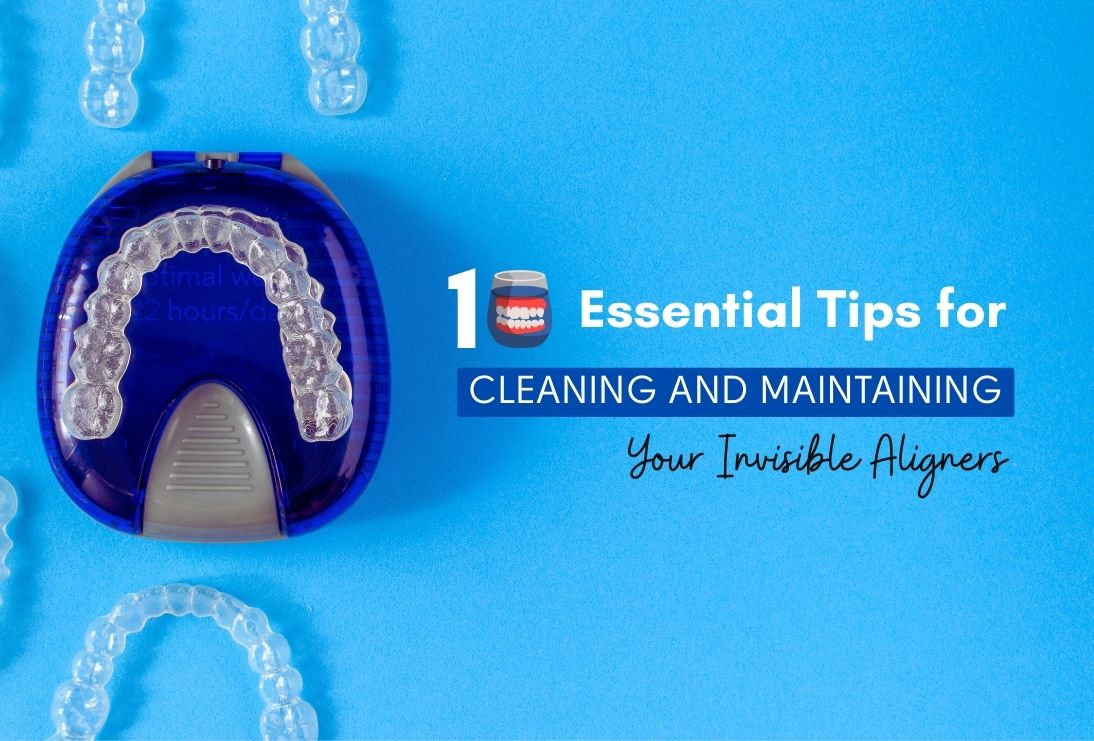
Invisible aligners, such as Invisalign and other clear braces, are a popular orthodontic option for people who want a straighter smile without the wires and brackets of traditional braces. These custom-made, transparent trays gently shift your teeth into place—while remaining nearly invisible. But with this convenience comes responsibility: proper cleaning and maintenance are essential to keep your aligners clear, odor-free, and effective.
At Teeth Care Multispeciality Dental Clinic, we’ve seen incredible results from aligner treatments—but we’ve also seen how poor hygiene can lead to bad breath, tooth decay, gum infections, and even extended treatment time.
In this guide, we’ll cover 10 essential tips to help you care for your invisible aligners properly, keeping your smile healthy and your aligners in top condition.
Invisible aligners are worn up to 22 hours a day, meaning they’re in constant contact with your teeth, saliva, and food particles. Without a proper cleaning routine, aligners can:
Poor aligner hygiene can also cause gum disease, tooth decay, and bad breath—issues that no one wants during orthodontic treatment. By following these essential tips, you can avoid all of that and enjoy a smoother, healthier smile journey.
Wearing aligners means you're covering your teeth for up to 22 hours a day. During this time, bacteria and plaque can easily become trapped between your aligners and teeth. If your trays aren’t kept clean, it can result in:
Maintaining a thorough and consistent cleaning routine not only protects your oral health but ensures that your aligners remain virtually invisible—just as they were designed to be.
Each time you remove your aligners—for eating, drinking anything other than water, or brushing your teeth—you should rinse them with lukewarm water.
Why it matters:
Expert Tip: Never use hot water, as it can warp the plastic and affect the fit of your aligners. Always opt for lukewarm or cool water when rinsing.
Your aligners need to be brushed just like your teeth—at least twice a day, ideally during your morning and evening brushing routines.
Steps to clean effectively:
Avoid toothpaste! Even non-abrasive pastes can scratch the aligner surface, making them more visible and prone to bacteria.
A daily soak helps eliminate bacteria and removes buildup that regular brushing might miss.
Recommended soaking solutions:
How to soak:
Avoid DIY solutions like vinegar or hydrogen peroxide unless advised by your orthodontist—they may weaken the plastic or irritate your gums.
Your aligners are not designed to withstand chewing or exposure to acidic or sugary drinks.
Consequences of eating or drinking with aligners in:
Always remove your aligners before meals, and brush your teeth before reinserting them.
One of the most common ways people lose or damage their aligners is by leaving them out in the open or wrapping them in tissue.
Why you should always use the case:
Bonus Tip: Clean your aligner case every couple of days with soap and warm water to prevent bacteria buildup inside the container itself.
It’s essential to remove all food debris and plaque from your teeth before putting aligners back in. Otherwise, you're trapping bacteria against your enamel.
Benefits of pre-insertion cleaning:
If you’re unable to brush immediately after eating, rinse your mouth thoroughly with water or chew sugar-free gum until you can brush properly.
On-the-go Tip: Carry a travel-sized toothbrush and floss kit in your bag or at your workplace to keep up with your oral hygiene anywhere.
While it might be tempting to use bleach or whitening products for “extra cleaning power,” these can cause more harm than good.
What to avoid:
Safe alternatives:
Always consult your orthodontist if you’re unsure about a cleaning product.
Even with proper care, aligners can sometimes become damaged or start to discolor.
Check for:
If you notice any of these, contact your orthodontist right away. Damaged aligners may need to be replaced to prevent delays in treatment.
At Teeth Care Multispeciality Dental Clinic, we offer quick replacement options and emergency support to keep your treatment on track.
Inconsistency is the enemy of oral hygiene. Skipping just one or two cleanings can lead to bacterial growth and plaque accumulation.
Sample Daily Routine:
Set daily phone alarms or use an Invisalign app to track your wear time and hygiene habits.
Even if everything seems fine, regular dental checkups are essential during your aligner treatment.
Why check-ups matter:
At Teeth Care Multispeciality Dental Clinic, we schedule timely follow-ups and provide continuous support throughout your clear aligner journey.
Invisible aligners have transformed orthodontic treatment by offering a discreet, comfortable, and highly effective alternative to traditional braces. But the success of your treatment doesn’t just depend on wearing your aligners for the recommended 20–22 hours a day—it also depends on how well you clean and maintain them.
We've explored ten essential tips that form the foundation of good aligner hygiene:
These aren’t just suggestions—they’re critical habits that will help you avoid unpleasant issues like bad breath, tooth decay, gum infections, and even costly delays in your treatment progress.
And you don’t have to do it all alone. At Teeth Care Multispeciality Dental Clinic, we go beyond just providing aligners—we educate, support, and guide you through every stage of your orthodontic journey. Whether you have questions about cleaning solutions, want a professional cleaning, or need a replacement tray, our experienced team is just a call away.